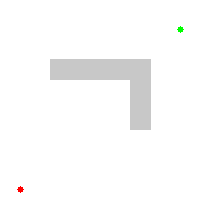A* arama algoritması
| A* arama algoritması | |
|---|---|
 A* algoritmasının engel bulunan bir uzayda hedefe giden yolu bulması. | |
| Sınıf | Arama algoritması |
| Veri yapısı | Çizge |
| Zaman karmaşıklığı | |
| Alan karmaşıklığı | |
A* arama algoritması, sezgisel bir çizge dolaşma ve yol bulma algoritmasıdır. Tamlığı, optimalliği ve optimal verimliliği ile bilgisayar biliminin birçok alanında kullanılmaktadır.[1] Tüm düğümleri belleğinde tuttuğundan olan alan karmaşıklığı dezavantajıdır.
İlk olarak 1968'de Stanford Araştırma Enstitüsü'nden Peter Hart, Nils Nilsson ve Bertram Raphael tarafından yayınlanmıştır.[2]
Sözde kod[değiştir | kaynağı değiştir]
function reconstruct_path(cameFrom, current)
total_path := {current}
while current in cameFrom.Keys:
current := cameFrom[current]
total_path.prepend(current)
return total_path
function A_Star(start, goal, h)
openSet := {start}
cameFrom := an empty map
gScore := map with default value of Infinity
gScore[start] := 0
fScore := map with default value of Infinity
fScore[start] := h(start)
while openSet is not empty
current := the node in openSet having the lowest fScore[] value
if current = goal
return reconstruct_path(cameFrom, current)
openSet.Remove(current)
for each neighbor of current
tentative_gScore := gScore[current] + d(current, neighbor)
if tentative_gScore < gScore[neighbor]
cameFrom[neighbor] := current
gScore[neighbor] := tentative_gScore
fScore[neighbor] := tentative_gScore + h(neighbor)
if neighbor not in openSet
openSet.add(neighbor)
return failure
Kaynakça[değiştir | kaynağı değiştir]
- ^ Russell, Stuart; Norvig, Peter (2020). Artificial Intelligence: A Modern Approach (4. bas.). Pearson Education. s. 108. ISBN 978-1-292-40113-3.
- ^ Hart, P. E.; Nilsson, N. J.; Raphael, B. (1968). "A Formal Basis for the Heuristic Determination of Minimum Cost Paths". IEEE Transactions on Systems Science and Cybernetics. 4 (2): 100-107. doi:10.1109/TSSC.1968.300136.



